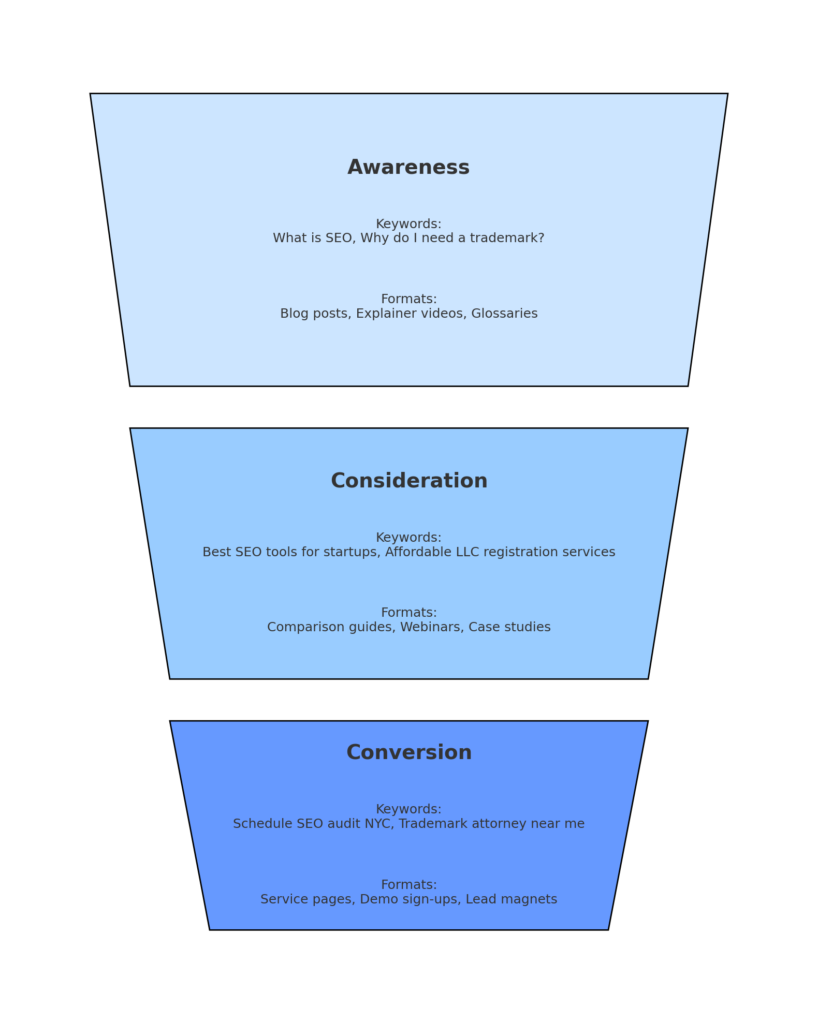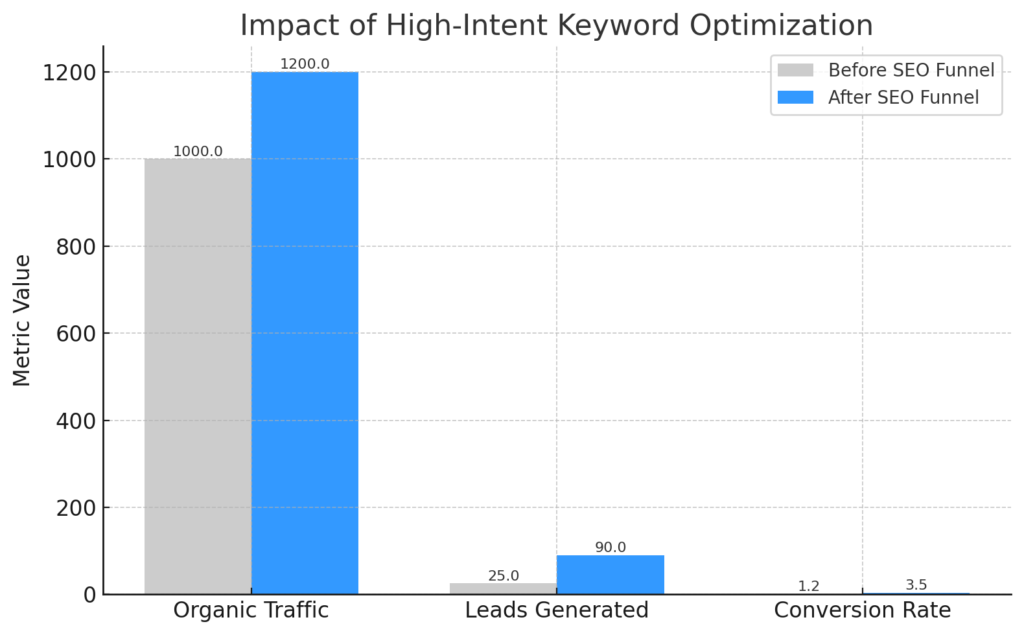In the world of SEO, not all traffic is created equal. Ranking for broad terms might give you volume, but ranking for high-intent keywords is what drives real business results. These keywords bring in users who are closer to making a decision—and that’s where the SEO funnel comes in.
In this guide, we’ll explore how to identify, map, and use high-intent keywords at every stage of the funnel to maximize conversions and long-term growth.
What Are High-Intent Keywords?
High-intent keywords are search terms that show a clear intent to take action—like buying a product, booking a service, or requesting a consultation. They are often:
- Long-tail in nature
- Specific to products or services
- Action-driven (e.g., “buy,” “get,” “schedule,” “hire”)
Examples:
- “Best CRM software for real estate agents”
- “Hire a startup SEO consultant in NYC”
- “Affordable trademark registration services”
These searches signal that the user isn’t just browsing—they’re ready to act.
Why High-Intent Matters More Than Ever
With AI-driven search and zero-click SERPs on the rise, attention spans are shrinking and competition is increasing. You need to:
- Target users who are already in a decision-making mindset
- Serve content that directly supports their intent
- Convert traffic, not just attract it
Ranking for “SEO” might bring visitors. Ranking for “SEO consultant for SaaS startups” brings leads.
Voice Search Consideration
Many high-intent keywords are naturally conversational. This makes them a strong fit for voice search optimization as well. For example, someone asking, “Who is the best SEO consultant for SaaS companies?” is clearly closer to taking action. Structuring your content for voice queries can further increase visibility.
Understanding the SEO Funnel
To optimize your keyword strategy, align it with the user’s journey. The SEO funnel typically includes:
1. Awareness Stage (Top of Funnel)
- Keywords: “What is SEO,” “Why do I need a trademark?”
- Goal: Educate and attract first-time visitors
- Content: Blog posts, guides, explainer videos
2. Consideration Stage (Middle of Funnel)
- Keywords: “Best SEO tools for startups,” “Affordable LLC registration services — building trust here is key. Learn how in our Notability & PR SEO Strategy“
- Goal: Help users compare and evaluate options
- Content: Comparison articles, buyer guides, webinars
3. Conversion Stage (Bottom of Funnel)
- Keywords: “Schedule SEO audit NYC,” “Trademark attorney near me”
- Goal: Drive action—purchase, sign-up, contact
- Content: Service pages, product landing pages, free consultations
Visual Representation: SEO Funnel with Keyword Types

How to Find High-Intent Keywords
Start with:
- Google Search Console: Identify queries already driving conversions
- Google Ads Keyword Planner: Look at commercial intent
- SEMrush / Ahrefs: Use filters for long-tail and transactional terms
- Customer Interviews: Find out what phrases real clients use before buying
Also, check your CRM, internal site search, and support tickets. People often describe their pain points clearly in these places.
Mapping Keywords to Funnel Stages
At each stage of the funnel, the content format you choose can make or break user engagement. Here’s a quick snapshot of what works best:
Best Content Formats by Funnel Stage
- Awareness: Blog posts, explainer videos, glossaries
- Consideration: Comparison guides, webinars, case studies, FAQs
- Conversion: Landing pages, demo sign-ups, service pages, lead magnets
Here’s how a startup-focused SEO agency might structure content:
| Funnel Stage | Keyword Example | Content Type |
|---|---|---|
| Awareness | “What does an SEO agency do?” | Blog post |
| Consideration | “Top SEO agencies for SaaS” | Comparison article |
| Conversion | “Hire B2B SEO consultant NYC” | Service landing page |
Internal Linking Across Funnel Stages
| From Page | Links To | Why |
|---|---|---|
| Blog: “Why SEO matters” | Comparison: “Top B2B SEO tools” | Moves reader deeper into funnel |
| Tools Comparison | Service Page | Drives user to conversion stage |
Optimizing for Conversion
It’s not enough to target the right keywords—you also need to:
- Match search intent with the right format and CTA
- Ensure pages load fast and are mobile-optimized
- Include trust signals (testimonials, guarantees, security badges)
- Add schema for enhanced search features — see our Schema Markup & Entity SEO Guide for details (FAQ, reviews, etc.)
Real Example: Funnel Optimization in Action
Let’s say your business offers legal services for startups:
- Top of Funnel: “Legal mistakes startups make” → blog with email capture
- Middle Funnel: “Best legal structures for startups” → comparison guide with gated checklist
- Bottom Funnel: “Hire startup lawyer NYC” → landing page with booking form
This funnel ensures your content attracts, nurtures, and converts visitors at every stage.
**Mini Case Study: After targeting the term “affordable legal help for startups in California,” one firm saw a 3.6x increase in qualified leads in just 60 days—despite only a modest increase in traffic. This shows how high-intent keywords drive ROI, not just impressions.

Here’s a quick look at what happened when a client shifted from broad to high-intent keywords across their SEO funnel.
As shown below, leads increased by over 3.5x and conversion rates tripled—with only a modest traffic bump.Want more? See how schema, strong content formats, and expert positioning impact conversion in our Schema & NEEAT Alignment Case Study.
Aligning with Google’s NEEAT Framework
Google’s NEEAT (Notability, Experience, Expertise, Authoritativeness, Trust) framework rewards well-rounded, trustworthy content:
- Notability: Use branded, specific keywords that users already associate with your services
- Experience: Include first-hand knowledge and examples
- Expertise: Ensure the content is created by or in collaboration with subject-matter experts
- Authoritativeness: Mention publications, awards, or client success stories
- Trust: Use schema, clear CTAs, real authorship, and testimonials
Mapping keywords by intent and using them in highly trustworthy content naturally aligns with NEEAT.
Common Mistakes to Avoid
- Targeting only TOFU (top-of-funnel) keywords
- Ignoring search intent when creating content
- Having good keywords but poor UX or slow site speed
- No internal linking between funnel stages
FAQs
What tools are best for finding high-intent keywords?
SEMrush, Ahrefs, Google Ads Keyword Planner, and even customer-facing data like support tickets or CRM notes are great starting points.
Can high-intent keywords have low search volume?
Yes—and that’s okay. These keywords often convert better because they indicate the user is ready to take action.
How many funnel stages should I target?
All three: Awareness, Consideration, and Conversion. Each plays a role in guiding the user toward becoming a customer.
How do I know if my keyword is high-intent?
Ask: Would someone using this keyword be likely to take action soon? If yes, it’s high intent. Look for specific actions like “hire,” “buy,” “get,” or “schedule.”
Final Thoughts
In 2025, the SEO game is less about traffic volume and more about qualified traffic. High-intent keywords help you connect with users who are actively seeking solutions. When you align those terms with the right content and funnel stage, you stop chasing traffic—and start closing leads.
Start by mapping your existing content to the funnel. Then fill in the gaps with keyword research and tailored, high-converting content.
Want help building an SEO funnel that converts? Let’s talk.
For a complete breakdown of how Notability, Experience, Expertise, Authoritativeness, and Trust shape modern SEO strategies, read our full guide: NEEAT – Future of SEO in 2025
